What kinds of promotions and activities does your store have planned for the month of October? Carving your logo into a pumpkin? Gluten-free pies in your café?
In honor of Breast Cancer Awareness month, perhaps you should add a women’s health focus to your planning. Women are the key shoppers in most households, and their varied health needs are ones you can help with.
Putting an End to PMS. Period.
“Going with the flow” is easier said than done during that time of the month. Whether its cramps, irritability, fatigue, aches or swelling, the vast majority of women experience at least one premenstrual syndrome (PMS) symptom every month (1).
But, that doesn’t mean there is no hope in sight. Shoppers may want to consider a two-step approach to dealing with PMS, beginning with hormonal support. This time of the month is well known for causing hormonal changes that may be the cause of monthly acne, emotional changes and more. According to Susan Hazels Mitmesser, Ph.D., director of nutrition research, Solgar, Leonia, NJ, women may want to know how omegas can help. “Omegas, such as GLA found in borage oil, provide support during the menstrual cycle by modulating prostaglandin production,” she states.
Some women have found that GLA is helpful when headaches, irritability, bloating and breast tenderness accompany their cycle. Also, omega-3s from marine oils may reduce cramping, bloating and moodiness.
Dr. Marita Schauch, B.Sc., N.D., 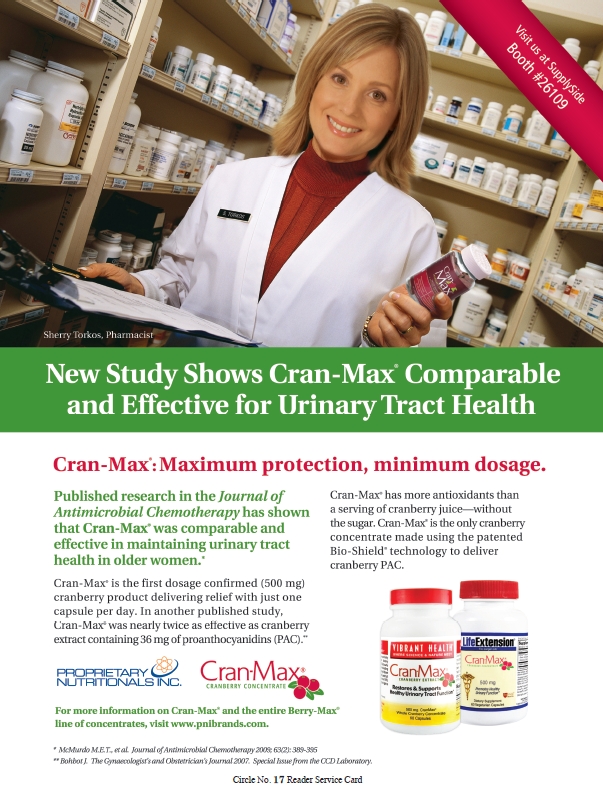 www.doctormarita.com, health educator for Natural Factors, Monroe, WA, calls vitex (a.k.a. chasteberry) the “single most important plant for the treatment of PMS” for its effects on a woman’s hormones. Vitex affects the production of luteinizing hormone (LH) and “has an effect that favors progesterone and inhibits prolactin (elevated prolactin levels may be a factor in PMS as well),” says Schauch. This may benefit women who experience breast tenderness before menstruation.
www.doctormarita.com, health educator for Natural Factors, Monroe, WA, calls vitex (a.k.a. chasteberry) the “single most important plant for the treatment of PMS” for its effects on a woman’s hormones. Vitex affects the production of luteinizing hormone (LH) and “has an effect that favors progesterone and inhibits prolactin (elevated prolactin levels may be a factor in PMS as well),” says Schauch. This may benefit women who experience breast tenderness before menstruation.
Women taking vitex have also reported improvements in PMS-related headaches, cramping, bloating, mood swings and irritability. Cheryl Myers, chief of education and scientific affairs at EuroPharma, Inc., Green Bay, WI, weighs in about the proper dosage: “With chasteberry, more doesn’t necessarily mean better.”
She cites a study in which either a placebo or different doses (8, 20 and 30 mg) of vitex were taken over three menstrual cycles. Researchers found a 20-mg dose of chasteberry provided significant improvements over placebo. “In fact, over half of the women in the chasteberry group had a 50% or greater improvement in their PMS symptoms,” says Myers (2). The 30-mg dose didn’t provide much improvement over the 20-mg dose.
There’s more to be said about natural ways to support hormonal balance. Another hormonal link, according to Schauch, involves supporting the liver’s role in estrogen metabolism. “If the liver is sluggish and compromised, this can lead to inadequate estrogen metabolism, creating estrogen dominance,” she explains.
If estrogens are methylated, they can be excreted more easily. Adequate intake of vitamins B6, B12 and folic acid are important for this process, while glutathione and vitamin C may also promote proper excretion (3). According to Gene Bruno, M.S., MHS, director of category management for Twinlab Corporation, New York, NY, B6 is linked to reducing PMS-related breast tenderness and depression, with appropriate doses ranging from 50 to 200 mg/day.
 Other women find dealing with inflammation helps them feel better during their cycle. One powerful antioxidant, a branded French maritime pinebark extract called Pycnogenol (Horphag Research), has been studied for its anti-inflammatory effects. States Sebastien Bornet, director of global marketing at Horphag Research, with U.S. offices in Hoboken, NJ, “A study published in the Journal of Reproductive Medicine found that Pycnogenol acts as a natural anti-inflammatory and can naturally soothe the discomfort associated with menstrual symptoms, as well as alleviate cramping and abdominal pains without side effects.”
Other women find dealing with inflammation helps them feel better during their cycle. One powerful antioxidant, a branded French maritime pinebark extract called Pycnogenol (Horphag Research), has been studied for its anti-inflammatory effects. States Sebastien Bornet, director of global marketing at Horphag Research, with U.S. offices in Hoboken, NJ, “A study published in the Journal of Reproductive Medicine found that Pycnogenol acts as a natural anti-inflammatory and can naturally soothe the discomfort associated with menstrual symptoms, as well as alleviate cramping and abdominal pains without side effects.”
Another study published in the European Bulletin of Drug Research found Pycnogenol reduced abdominal discomfort by 80% and cramping by 77% in women with menstrual pain (4). These effects were seen after one cycle, and benefits increased even more after subsequent cycles.
Diet can also play a big role in one’s PMS symptoms by way of reducing inflammation. Says Schauch, “Other studies confirm that an increase in C-reactive protein, a marker of inflammation, is positively correlated with the severity of PMS symptoms.” She suggests reducing the intake of pro-inflammatory foods such as sugar, cheese, milk, white flour, white rice and hydrogenated oils and increasing healthy anti-inflammatory foods such as fresh fruits and vegetables, fish, grass-fed beef and organic, lean proteins such as chicken and turkey, nuts, seeds, turmeric, garlic and onions.
Sugar and dairy can affect the body’s levels of magnesium. States Schauch, “Dairy products alter magnesium absorption and refined sugars increase the excretion of magnesium through the urine. There is also data confirming that women with PMS consume greater amounts of dietary fat, carbohydrates and simple sugars but lower amounts of protein.”
Josée Fortin, naturopath, biochemist and a spokesperson for A.Vogel, with U.S. Bioforce offices in Ghent, NY, also speaks of the importance of magnesium during one’s monthly cycle. She says the mineral is “a natural muscle relaxant that can help with cramps (200–400 mg every day of the month).”
Magnesium is also said to support healthy mood, fluid retention and even PMS-related migraines. The mineral may accomplish all this by modulating neurotransmitter levels, says Bruno.
Women should know that they may need a few cycles before they experience the full benefit of these supplements. Bruno advises, “Stick with it, and don’t get discouraged.”
Probiotics for Women’s Health
Some women seem prone to yeast and bacterial infections. If there is an imbalance of vaginal microflora, probiotics might help, but be careful about which ones you recommend. States Hazels Mitmesser, “Some strains of probiotics have more scientific research for women’s health than others.”
While probiotics won’t directly kill harmful 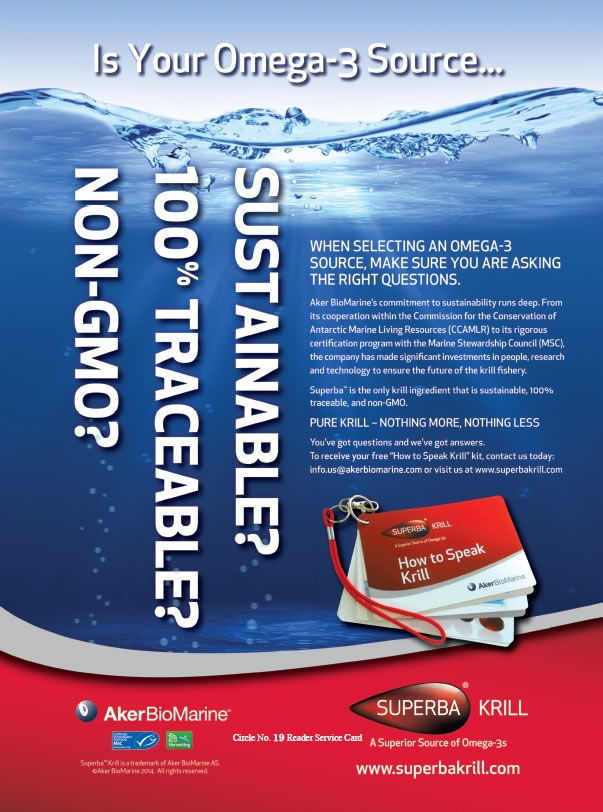 bacteria, they will raise the good count gradually. “When you have a healthy flora, the good bacteria produce some lactic acid to maintain a proper intestinal pH that will allow them to function well,” Fortin states. Unfortunately, not consuming enough fiber, taking antibiotics, drinking coffee and dealing with stress can negatively affect the population of good bacteria “and if there are less, less lactic acid is produced and the pH environment is changing,” says Fortin.
bacteria, they will raise the good count gradually. “When you have a healthy flora, the good bacteria produce some lactic acid to maintain a proper intestinal pH that will allow them to function well,” Fortin states. Unfortunately, not consuming enough fiber, taking antibiotics, drinking coffee and dealing with stress can negatively affect the population of good bacteria “and if there are less, less lactic acid is produced and the pH environment is changing,” says Fortin.
So, which ones may help your clientele the most? Schauch recommends Lactobacillus, since it helps contribute to a low vaginal pH; a low pH of 3.5–4.5 indicates that there is just the right amount of good bacteria and no overgrowth of itch-, odor- and infection-causing bad bacteria (5). “[Lactobacilli] is so important in maintaining healthy vaginal microflora,” she states. “[It] has also been shown to prevent the adherence of bad disease-causing bacteria.”
Fortin says you can support a woman’s unique microflora by also supporting that of the digestive tract, especially the large intestine, where the highest concentrations of good bacteria live in our body. She adds, “The bladder, the vagina and the colon are all in the same area and it seems that when you rebalance the intestinal flora, it has positive effects on the vaginal tract and the urinary tract (some say the bacteria seeps through the membranes and go from one to the other but it is not clear exactly what is happening).”
Another alternative, says Fortin, could be a branded formula (Molkosan from A.Vogel) with a very high concentration of lactic acid per dose that rapidly reestablishes a proper pH environment in the gut and “will rapidly make a huge difference in the intestinal flora,” she states. According to Fortin, one study found most people taking the supplement had a 42–53% improvement in digestive problems. She adds, “Not only has it been shown to stimulate the growth of lactic bacteria, but by increasing the concentration of lactic acid in the gut, it also helps eliminate harmful bacteria and Candida.”
Dealing with Menopause
Menopause symptoms differ for each woman, but some are more prevalent than others. Here are a few common symptoms and some ideas for dealing with them.
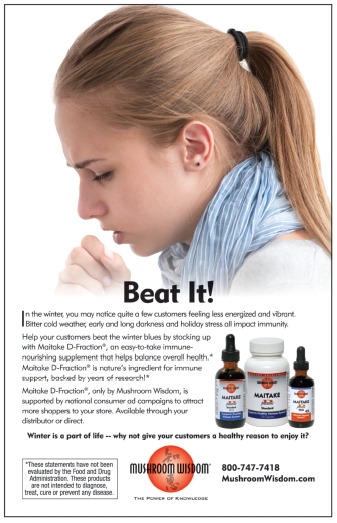 Hot flashes. Fortin says women living in North America have more symptoms than women living elsewhere, with one survey finding “88% of them having hot flashes during menopause and 79% of them having night sweats (same as hot flashes but at night).”
Hot flashes. Fortin says women living in North America have more symptoms than women living elsewhere, with one survey finding “88% of them having hot flashes during menopause and 79% of them having night sweats (same as hot flashes but at night).”
While hot flashes and night sweats are often the butt of jokes, they can truly be uncomfortable—sometimes life-altering. Fortin says night sweats can even disrupt sleep for a few hours every night, causing fatigue during the day. Again, hormonal changes could be to blame, since they affect the area of the brain (i.e., the hypothalamus) that controls body temperature.
Some hot flash sufferers have had good experiences with using sage to combat hot flashes during menopause. Fortin says a high-concentration sage formulation from her company has been proven to help reduce the frequency and intensity of hot flashes. She states, “Women who take this product usually have a lot less hot flashes and the ones they have are a lot less bothersome and disruptive.”
Hot flashes are one of the many menopause symptoms that black cohosh is said to help. “It has well over a dozen human clinical studies published on it showing it to be very, very effective for menopause,” says Bruno. “It has tremendous, solid research behind it.”
Schauch agrees that the herb is “one of the most extensively studied herbs for menopausal symptoms.” One of the largest trials involved 629 menopausal women who took black cohosh for six to eight weeks (6). “As early as four weeks after beginning the therapy, a clear improvement in the menopausal ailments was seen in approximately 80% of the women,” says Schauch. After another two to four weeks, she says symptoms completely disappeared in about half of the women.
While black cohosh’s mechanism of action isn’t clear, Schauch says it “may have an effect on serotonin levels or bind to opiate receptors and control temperature regulation.”
Since black cohosh does not bind to estrogen 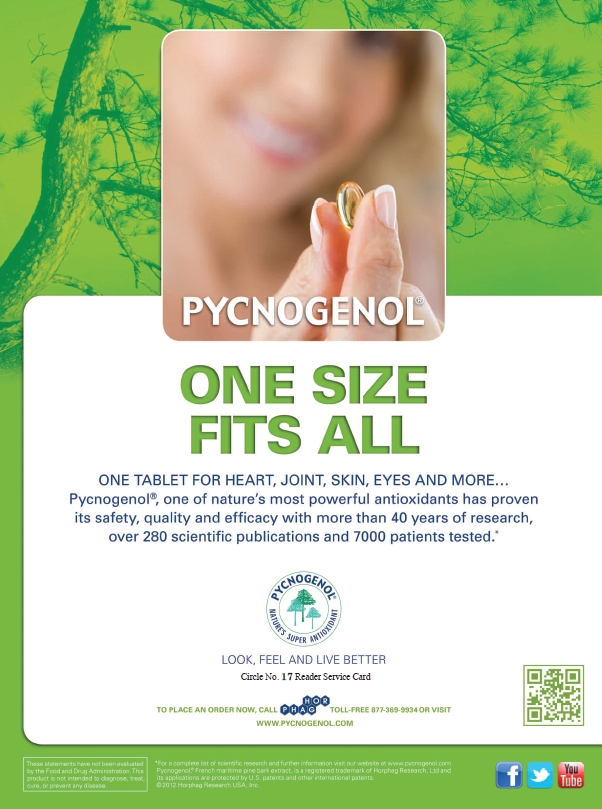 receptors, Bruno says the herb can be used with others like standardized hops cone extracts. “Some nice double-blind placebo-controlled studies show they’re helpful in dealing with hot flashes and menopausal discomfort,” he states.
receptors, Bruno says the herb can be used with others like standardized hops cone extracts. “Some nice double-blind placebo-controlled studies show they’re helpful in dealing with hot flashes and menopausal discomfort,” he states.
And, soy isoflavones may be beneficial to women going through menopause. States Hazels Mitmesser, “Isoflavones are popular for their use during menopause as it helps with mild mood changes, hot flashes, night sweats and occasional sleeplessness.”
Bornet says Pycnogenol may help, too. The extract supports vascular relaxation, he states, “which allows the body to rid of excess body heat, subsidizing the sensation of hot flashes and nighttime sweating.”
Women concerned about night sweats, says Fortin, may also want to try avoiding certain foods known to aggravate hot flashes like spicy foods and stimulants like coffee, tea, alcohol, refined sugars and chocolate.
Sleeping problems. Night sweats often trigger sleeplessness, but sometimes, insomnia is a separate menopause symptom unto itself. “This is simply an imbalance in neurotransmitters that is aggravated by the change in hormones,” says Fortin, offering up valerian root as an option because it “is known to help the production of several neurotransmitters and is a strong sedative. When combined with hops, they have a synergistic effect (1+1=3), allowing a deeper, restorative sleep,” she states.
Urinary tract troubles. After menopause, women are at an increased risk of bladder and urinary tract infections. As estrogen production declines during this time, beneficial bacteria decline. Coupled with this, the bladder becomes less elastic and doesn’t empty as efficiently as it once did. Cranberry extract  may help reduce infections as it hinders the ability of bacteria to adhere to the lining of the urethra and bladder. Supplement form may be preferred over cranberry juice since they don’t have the sugar content. Probiotics intake may also help tip the balance of good to bad bacteria in a woman’s favor.
may help reduce infections as it hinders the ability of bacteria to adhere to the lining of the urethra and bladder. Supplement form may be preferred over cranberry juice since they don’t have the sugar content. Probiotics intake may also help tip the balance of good to bad bacteria in a woman’s favor.
Difficulty focusing. About 60% of women going through menopause feel as though they are in a fog, says Fortin. They have trouble concentrating and feel disoriented. For this, Fortin recommends an oat extract from her company that has naturally occurring phospholipids and minerals that help calm and “also have a tonic effect that sharpen concentration and focus.” It may also promote normal libido, something that is often lost during menopause (more on this topic next).
Fortin says another helpful herb is St. John’s Wort, which has much historic use for supporting healthy moods and a calm state of mind. “It has been shown to have a tonic effect on the nervous system and some research studies even indicate it supports a better production of neurotransmitters,” Fortin explains.
Vitality loss. Fortin says 40% of menopausal women feel a loss of sexual vitality. Information from Sinclair Institute suggests that there are many reasons for this, including nutritional deficits, stress, fatigue and more (7). Michael Jeffers, president of Helios Corp, Santa Fe, NM, points to a woman’s declining estrogen levels during menopause as a cause.
Decreased sexual vitality may be related to low thyroid and poor adrenal function caused by fluctuating testosterone levels and estrogen loss, adds Schauch. Therefore, she recommends supplements that “naturally increase testosterone levels, support thyroid and adrenal function and help women naturally transition through menopause.”
The pituitary gland is “the master gland,” says Fortin, because it controls other glands’ hormonal secretions. “The pituitary works very closely with the hypothalamus, a larger area linked to our brain that includes the emotional center,” she says. “An overactive pituitary can then affect our emotional state, increasing irritability, mood swings, anxiety—and even libido.” Fortin recommends Avena sativa for help, because it nourishes and calms the pituitary gland. She states, “If the pituitary is stronger and healthier, it will be more effective in directing other glands, the mind calms down, sleep is better and the emotional state is improved. All this can contribute to an improved libido.”
L-theanine may be an option, too, if stress is contributing to a loss of vitality. Bruno says that at 50–100 mg/day, this amino acid can help “significantly reduce feelings of stress and anxiety and create a calming effect without inducing drowsiness” by increasing alpha-wave activity in the brain.
Women whose loss of vitality is related to fatigue may want to consider a maca  product, which may help improve energy, stamina and sex drive, says Myers. “I think it’s safe to say that most people feel much more ‘in the mood’ when they aren’t exhausted by the demands of the day,” she states.
product, which may help improve energy, stamina and sex drive, says Myers. “I think it’s safe to say that most people feel much more ‘in the mood’ when they aren’t exhausted by the demands of the day,” she states.
Myers continues, “There’s plenty of evidence to back up maca, and more studies are being published all the time, but I think that one stands out in particular.” A study from CNS Neuroscience & Therapeutics involved individuals taking prescription antidepressant drugs, which decreased or eliminated their sex drive (8). “Daily intake of three grams of maca resulted in improved sex drive, and improved overall sexual satisfaction,” says Myers. “For those who think that maca is only for men, consider this: over 75% of the people in this study were women.”
Rebecca Cook, senior director of sales and marketing for mass market at Sinclair Institute, Hillsborough, NC, says sometimes just trying something new and different may help couples get back in the mood. For women, she believes a natural arousal balm made with organic coconut and castor oils from her company may help. These ingredients also soothe and protect vaginal tissue.
Dryness. The lining of the vagina changes during menopause, becoming thinner and dryer. “That can be uncomfortable, especially if there’s not enough lubrication,” says Bruno.
Natural water-based lubricants and moisturizers may go a long way to help reduce dryness, with gentle ingredients like coconut oil, aloe, vitamin E and calendula. By contrast, “most non-natural OTC lubricants contain chemicals similar to those found in oven cleaner,” says Cook.
Women can also try vitamin E, says Fortin. With a doctor’s permission, she says it can be inserted vaginally and it lubricates the membranes and has a slight estrogenic effect, “which is enough to rebalance the hormonal level locally.”
When dryness is a problem, women may find traditional feminine hygiene products to be too drying and uncomfortable during their remaining periods. Tampons and pads made with organic cotton may be more comfortable and less drying and irritating—not to mention better for the environment—than those bleached with chemicals.
Shoppers that don’t like tampons or sanitary napkins may want to consider a menstrual cup. One company, Diva International, says its products are made of chemical-free health care-grade silicone that doesn’t leave any trace residue. Since it collects instead of absorbs menstrual flow, the company says it doesn’t dry out or disrupt the natural environment or pH of the vaginal canal.
 In addition to dryness, vaginal elasticity may diminish during menopause, too. Cook suggests exercising the pubococcygeus muscle may “not only improve incontinence issues brought on by menopause, but also improve blood flow to help rejuvenate vaginal tissue and increase natural lubrication.” Her company offers medical-grade products for this process.
In addition to dryness, vaginal elasticity may diminish during menopause, too. Cook suggests exercising the pubococcygeus muscle may “not only improve incontinence issues brought on by menopause, but also improve blood flow to help rejuvenate vaginal tissue and increase natural lubrication.” Her company offers medical-grade products for this process.
Oral dietary supplements may also reduce vaginal dryness. Bornet says that clinical research found daily supplementation of Pycnogenol improved dryness after eight weeks. Meanwhile, Myers believes omega-7-rich sea buckthorn is also great for hydration.
Jeffers believes his company’s branded ingredient (EstroG-100) is one to consider for dryness, a benefit supported by several placebo-controlled, double-blind and randomized human clinical studies. “Separately, we ran an open label study where we demonstrated that vaginal dryness symptoms improved with three to four weeks when EstroG-100 was taken daily in 514-mg dosage rates,” he states.
Multitasking. Some women experience multiple symptoms, and many of the herbs discussed here wear several hats like sage, soy isoflavones and black cohosh, which Myers says “has repeatedly shown amazing benefits for relieving night sweats, irritability, hot flashes and mood swings. Because it does so well taking care of these symptoms, it also allows women to experience uninterrupted sleep—possibly for the first time in quite a while.” She adds that this botanical doesn’t have phytoestrogen content, but it does appear to be a selective estrogen receptor modulator. “The lack of phytoestrogens makes it safe to use for women who have had breast cancer,” she believes. She believes a daily dose of 13 mg of high-quality, concentrated black cohosh will benefit women going through menopause.
Another ingredient in the multitaskers camp is a branded botanical blend (EstroG-100 from Helios Corp.). According to Jeffers, the ingredient has been found to help multiple symptoms. “When we first started our first clinical, we expected the top three would be hot flashes, night sweats and mood swings,” Jeffers explains, noting that their research has found women feel their lives are affected by menopause in slightly different ways: first is insomnia, second is hot flashes (“can be very debilitating waking up 3-4 times a night burning up,” says Jeffers), third is night sweats, fourth is vaginal dryness (“direct effects on interpersonal relationships and family life,” he states) and last is the safety of the therapy. He feels the ingredient tackles all this and more.
Jeffers says his company’s research has uncovered two more important things about what women want from a menopause-relief product. “The key thing women want is relief and they want relief now, not in six weeks which is what most nutra choices offer. Secondarily women will not take something that is estrogenic because of the implications linking to the HRT/WHI study in 2002.” The Women’s Health Initiative (WHI) study was stopped prematurely when women on hormone replacement therapy (HRT) were found to have a 26% increase in invasive breast cancer, a 29% increase in heart attacks and a 41% increase in strokes. Therefore, many women want to avoid any products that effect estrogenicity or have a positive reaction with female receptor sites ER-alpha and ER-beta. States Jeffers, ”our ingredient, EstroG-100, went through vigorous testing to prove that EstroG-100 was not estrogenic.”
Pycnogenol is another ingredient that works on multiple aspects of menopause thanks to its ability to increase nitric oxide production, scavenge free radicals and provide benefits as an antioxidant. States Bornet, “Studies have shown Pycnogenol to substantially improve symptoms of perimenopause including mood swings, bloating, loss of libido and vaginal dryness—all factors that may contribute to decrease a woman’s sense of sexual vitality and impact quality of life. The findings of multiple studies suggest that Pycnogenol may serve as a natural alternative to estrogen replacement therapy.”
|
Top Fertility Options for Women Couples trying to conceive may be able to optimize reproductive health with the following ingredients. |
|
Targeting Breast Health
Women looking for breast health supplements have a lot of options (with a doctor’s approval). While they cannot treat or prevent disease, some research links natural supplements to an effect on breast health (and even breast cancer cells). For instance, Schauch says indole-3-carbinol (I-3-C) derived from cruciferous vegetables may help break down estrogen in the liver and help form “good” 2-hydroxyestrones. I-3-C breaks down into metabolites like DIM. “Both I-3-C and DIM bind to estrogen receptors, displacing excess estrogen or harmful estrogen metabolites. I-3-C and DIM have been shown to inhibit growth of human breast cancer cells and to stimulate cell death,” says Schauch.
Myers says studies indicate that estrogen-sensitive breast cancer cells that are exposed to iodine are less likely to proliferate. She cites a study on women with fibrocystic breast disease (9) in which “98% of women receiving iodine treatment were pain-free by the study’s end, and 72% had improvements in breast tissue.”
Vitamin D is another nutrient of interest. Myers says people are not getting nearly enough, especially since the old recommended daily requirements of 400 IUs is barely 10% of what the body needs, she states. “Clinical research has found that over 75% of breast cancer survivors in their studies were vitamin D deficient, and other studies conclude that high levels of vitamin D—much higher than our current recommendations—may reduce the risk of breast cancer by 50%,” says Myers.
Curcumin is being investigated by researchers for three important reasons, Myers says. “It stops cancer cells from forming, kills existing cancer cells and stops cancer cells from spreading,” she explains.
Standard curcumin doesn’t absorb well; researchers have used up to 10-12 grams daily to get even a small amount into the bloodstream, according to Myers. So, shoppers should choose a highly absorbed formulation that combines curcumin with something like piperine (such as Curcumin C3 Complex from Sabinsa), is blended with turmeric oils (like BCM-95 from Dolcas), is micronized (like Theracurmin) or uses curcuminoids.
Researchers have also linked the Maitake-D mushroom fraction to breast health. Cancer cell apoptosis was tied to the fraction at the highest dose in a 2011 study (10).
Bruno says CoQ10 may not always be associated with breast care, but it shouldn’t be overlooked. “They actually found [400 mg of CoQ10] helped to reduce metastases in breast cancer and reoccurrences. These were human studies,” he states.
A final go-to nutrient for breast support may be omega-5. Found in pomegranate seed oil, omega-5 is said to have some of the same actions as tamoxifen, an anticancer drug, “without the dangers and side effects,” says Myers. “Omega-5 from pomegranate seed oil has emerged as a very strong natural therapeutic agent. It is a powerful tumor inhibitor.”
The reason why, she believes, is that the oil contains punicic acid, which may inhibit estrogen-sensitive and estrogen-insensitive breast cancer cells. In a lab study on cancer cells (11), omega-5 “inhibited proliferation of two types of cancer cells by 92% and 96%, respectively. In that same study, omega-5 fatty acid (punicic acid) also supported apoptosis in two types of breast cancer cells, by 86% and 91%,” says Myers.
Pomegranate oil is also an aromatase inhibitor, with researchers finding it stops aromatase activity by 60–80% and inhibits MCF-7 breast cancer cells by 90% (12–13). Adds Myers, “The researchers stated that pomegranate has excellent chemopreventive potential—either on its own or in addition to conventional therapy—meaning less dependence on dangerous drugs.” WF
| Select Women’s Health Offerings | |
|
A.Vogel: Sage Menopause tabs, Venaforce Forte Gel or Tablets, Calcium Absorption Formula, St. John’s Wort Tablets, Valerian or Valerian Complex, Arnica Rub, Stress Management Drops, Thyroid Support Tablets, Cardiaforce Heart Drops, Herbatint. Diva International: The DivaCup, The DivaWash. EuroPharma, Inc.: Andes Organic Maca, PMS Relief, CuraMed, Tri-Iodine, Vitamin D3 Chewable, Menopause Relief, Omega-7 Seabuckthorn Extract. Fairhaven: Fertility, prenatal and breastfeeding supplements and support products. Helios: EstroG-100. Horphag Research: Pycnogenol. Natural Factors: Natural Factors WomenSense line: EstroSense, MenoSense, AdrenaSense, ThyroSense, Vitex, Black Cohosh, Rx Omega-3 Women’s Blend, UriSense, VeinSense, SexEssentials. Solgar: Female Multiple Tablets, SFP Black Cohosh Root Extract Vegetable Capsules, Non-GMO Super Concentrated Isoflavones Tablets, Probi 20 Billion and Probi 30 Billion Vegetable Capsules, Evening Primrose Oil 500 mg and 1300 mg Softgels [Probi and LP299v are trademarks of Probi AB.] Sinclair Institute: Sinclair SELECT USDA Certified Organic Lubricant & Moisturizer, Sinclair SELECT USDA Certified Organic Moisturizing Balm, Sinclair SELECT USDA Certified Organic Arousal Balm, Natural Contours ENERGIE Pelvic Floor Barbell, and Sinclair SELECT OPTIMA Twinlab: Pre-Natal Care, Mommi 3-in-1, Dual Action Menopause Response, Women’s Ultra Daily, and more including Alvita teas like Red Clover Tea, Raspberry Tea and Black Cohosh Root Tea. |
|
References
1. “Premenstural Syndrom Fact Sheet,” www.womenshealth.gov/publications/our-publications/fact-sheet/premenstrual-syndrome.html, accessed Aug. 30, 2014.
2. R Schellenberg, et al., “Dose-Dependent Efficacy Of The Vitex Agnus Castus Extract Ze 440 in Patients Suffering from Premenstrual Syndrome,” Phytomedicine. 19 (14), 1325–1331 (2012).
3. “The Liver's Role in Hormone Balance,” www.womensinternational.com/connections/liver.html/, accessed Sept. 2, 2014.
4. Horphag Research, www.pycnogenol.com/applications/more-applications/menstrual-discomfort/, accessed Sept. 2, 2014.
5. L. Streicher, “When Your Vagina’s in a Phunk,” www.doctoroz.com/blog/lauren-streicher-md/when-your-vagina-phunk, accessed Sept. 2, 2014.
6. H. Stolze, “The Other Way to Treat Symptoms of Menopause,” Gyne. 1, 14–16 (1982).
7. Y. Fulbright, “Where Did My Libido Go? Sexual Desire in Later Life,” http://sinclairinstitute.org/where-did-my-libido-go-sexual-desire-in-later-life/, accessed Sept. 2, 2014.
8. C.M. Dording, et al., “A Double-Blind, Randomized, Pilot Dose-Finding Study of Maca Root (L. Meyenii) for the Management of SSRI-Induced Sexual Dysfunction,” CNS Neurosci. Ther. 14 (3),182–191 (2008).
9. W.R. Ghent, et al., “Iodine Replacement in Fibrocystic Disease of the Breast,” Can. J. Surg. 36 (5), 453–460 (1993).
10. “Researchers: Mushroom Extract Leads to Breast Cancer Cell Death,” WholeFoods, 2011.
11. M.E. Grossmann et al., “Punicic Acid Is an Omega-5 Fatty Acid Capable of Inhibiting Breast Cancer proliferation,” Int. J. Oncol. 36 (2), 421–426 (2010).
12. N.D. Kim et al., “Chemopreventive and Adjuvant Therapeutic Potential of Pomegranate (Punica Granatum) for Human Breast Cancer,” Breast Cancer Res Treat. 71 (3), 203–217 (2002).
13. V.M. Adhami, et al., “Cancer Chemoprevention by Pomegranate: Laboratory And Clinical Evidence,” Nutr. Cancer 61 (6), 811–815 (2009).
Published in WholeFoods Magazine, October 2014


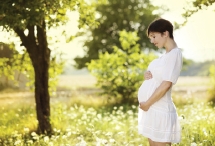 miscarriages. The active compounds found in Vitex can decrease prolactin levels in the body and level hormones that lead to a healthy pregnancy.
miscarriages. The active compounds found in Vitex can decrease prolactin levels in the body and level hormones that lead to a healthy pregnancy.







